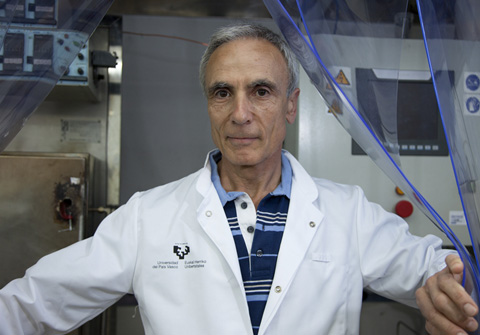The UPV/EHU's Catalytic Processes for Waste Valorisation research group is working on various lines of research relating to renewable energies, one of which corresponds to the obtaining of bio-oils or synthetic petroleum using biomass. In a paper recently published in the scientific journal Fuel, the researchers have proposed using artificial neural networks to determine the heating power of each type of biomass using its composition as it is a highly irregular material.
Neural networks to obtain synthetic petroleum
A research group of the UPV/EHU-University of the Basque Country has made progress in obtaining bio-oils and raw materials from biomass using its patented reactor
First publication date: 01/07/2016

Biomass is one of the main sources of energy and heat in the field of renewable energy production: it is any type of non-fossil organic matter, such as living plants, timber, agricultural and livestock waste, wastewater, solid urban organic waste, etc. The three most developed technologies for obtaining energy from biomass are as follows: pyrolysis (decomposition by heating in the absence of oxygen), gasification (reaction with air, oxygen or a blend of both and conversion into gas) and combustion (decomposition through heating with oxygen). The effectiveness and emission levels of these three processes change depending on the composition of the biomass as well as its properties, the experimental conditions and equipment used.
In collaboration with researchers at the University of Sao Carlos in Brazil and within the framework of a European project, members of the UPV/EHU's Catalytic Processes for Waste Valorisation research group analysed the process to set up a refinery to obtain bio-oils or synthetic petroleum using biomass. Since "afterwards, using the bio-oil produced it is possible to obtain the same products that are obtained from petroleum; hydrogen as well as any other compound," explained Martin Olazar, project leader and professor of the Department of Chemical Engineering. The reactor developed and patented by this research group, the conical spouted bed reactor, is highly suited to this process because it is suitable for handling irregular, sticky materials —biomass is a highly irregular material and difficult to handle using conventional technologies—.
Artificial neural networks to determine gross calorific value
In the design of the process to obtain bio-oils using biomass, certain variables need to be determined: the temperature that needs to be achieved, how this temperature is to be achieved, how much fuel (in this case how much biomass) needs to be burnt, etc. The gross calorific value is a key parameter in determining all these data: it is the heat (energy) that is released when a certain quantity of fuel is completely burnt. This parameter is essential in the analysis, design and improvement in biomass pyrolysis, gasification and combustion systems. The correlations existing in the literature give highly variable results depending on each type of biomass and its properties. So the researchers in the group are proposing that artificial neural networks be used to calculate this; they have proven empirically that the system gives very good results and they have reported on them in a paper recently published in the scientific journal Fuel.
Artificial neural networks are computer models based on the way biological neural networks function; the input and output databases are correlated through them. The researchers fed the system with data from the literature and from their own research and saw that highly reliable results were rapidly obtained, compared with the limited correlations existing in the literature. "These neural networks must be continually fed," explained Olazar, "as the results improve when broader case studies are incorporated. Through a simple composition analysis and by incorporating some regular data into the system (such as density and humidity, for example), the neural network provides us with the gross calorific value of the biomass we have available," he explained, "and that way we can more easily launch the calculations needed for our design. This is one of the links in the chain of the process to obtain synthetic petroleum using our technology and it is a hugely useful link," concluded Olazar.
Additional information
The Catalytic Processes for Waste Valorisation research group of the UPV/EHU's Faculty of Science and Technology reports to the Department of Chemical Engineering and comprises 50 lecturers and researchers. Martin Olazar leads the Design and renewable reactor applications sub-group, has a PhD and is professor of Chemical Engineering.
Photos: UPV/EHU.
Bibliographic reference
- 'Fitting performance of artificial neural networks and empirical correlations to estimate higher heating values of biomass'
- Fuel. vol. 180, 15 September 2016, Pages 377–383
- DOI: doi:10.1016/j.fuel.2016.04.051

